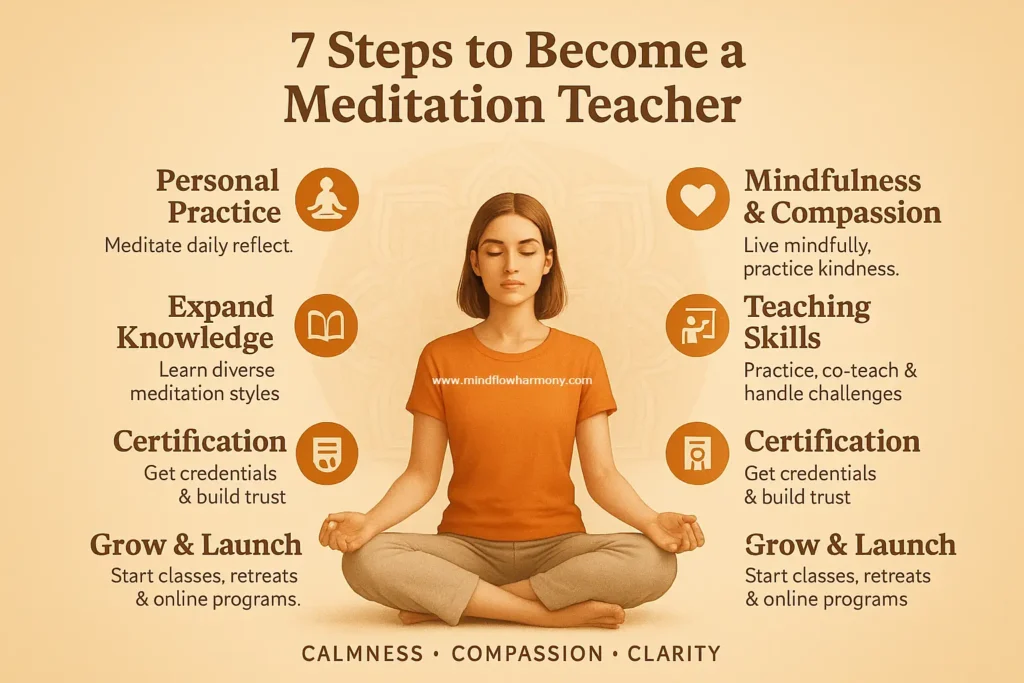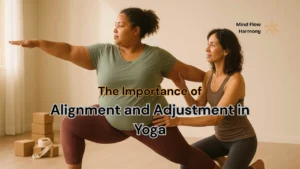Have you ever felt quite relaxed after meditating and wanted to share that feeling with others? Have you ever wondered how do you become a meditation teacher? As more and more people are looking for ways to calm their mind thus good meditation teachers are in demand.
This blog will show you how to turn your love of meditation into a career. There are certain steps given below which you can follow. You will learn what you need to know, the skills you need to develop, and how to get the experience to confidently teach others.
- Establish a Consistent Personal Meditation Practice: The foundation of your credibility as a teacher.
- Cultivate Mindfulness, Presence, Compassion & Loving-Kindness: Embodying the qualities you teach.
- Expand Your Knowledge of Diverse Meditation Techniques: Becoming a versatile guide for different needs.
- Hone Your Teaching & Facilitation Skills: Learning how to effectively lead and support others.
- Get Certified & Deepen Your Credentials: Building trust and expertise.
- Build Your Teaching Practice & Community: Finding your niche and connecting with your audience.
- Launch & Grow Your Classes, Workshops & Retreats: Sharing your passion with the world.
Steps to Be a Meditation Teacher

Check out the seven steps given below in detail that will help you to become a good meditation teacher.
Establish a Consistent Personal Meditation Practice
Before you can help others with meditation, you need to be good at it yourself. You should have a strong foundation in your meditation practice. You need to really understand meditation and how it helps you. Without proper knowledge and practice of meditation, you cannot teach others.
- Daily Ritual: Meditate daily at the same time. This creates a habit. Morning, lunch or evening consistency is key. Regular practice gives you credibility to teach.
- Tracking Progress: Track your meditation sessions. Use a journal, app (Headspace, Calm) or calendar. Note the date, time, length and your experience. This shows your progress and patterns. Your notes will reveal your growth.
- Reflect & Share: Reflect on your meditation experiences and how they affect your life. How does it help with stress or clarity? Use this in your teaching to show that you are genuine. Share your journey to build trust and inspire students.
Cultivate Mindfulness, Presence, Compassion & Loving Kindness
Being a meditation teacher simply means that you should know more than just how to sit quietly and breathe. You should develop good qualities like calmness and awareness that you can use all day long. People will look up to you to see these qualities in action.
- Mindful Living: Pay close attention to what you are doing even if it is a routine task like walking meditation. Notice the little things like how things feel, smell and sound. This helps you stay present and calm.
- Emotional Intelligence: Try to feel compassion and love for everyone including yourself. You can practice this by adopting exercises like loving-kindness meditations to deepen your compassion skills. This will help you connect with your students better.
- Teaching by Example: The best way to teach these qualities is to live them yourself. Be mindful, present, kind and understanding with your students. They will trust you and pay attention more if they see you practicing what you preach.
Expand Your Knowledge of Diverse Meditation Techniques
Meditation is personal. What works for one person might not work for another. As a meditation teacher, you need to know a lot of different ways to meditate so that you can help your students find what is best for them.
Four Core Categories Know the four main ways to meditate:
- Mindfulness Meditation: Pay attention to what is happening at present without judging it.
- Concentrative Meditation: Focus on one thing like your breath or a word.
- Breathwork Meditation: Use special breathing techniques to relax or feel energized.
- Spiritual Meditation: Connect to something bigger than yourself or a sense of meaning.
- Global Traditions: Learn about different meditation styles like Vipassana, Zen, Transcendental or Metta practices to serve others. Each style has unique ways to help you.
- Adaptation for Audiences: Learn to change meditation for different people like children, executives or trauma-informed groups. Use shorter practices for kids or stress relief for busy people. Also, learn how to teach safely if someone has been through something difficult.
Hone Your Teaching & Facilitation Skills
It is not enough to simply know about meditation. To be a good teacher, you need to learn how to actually teach it to others.
- Educational Theory Basics: Understand basic teaching ideas. Think about how to build on what people already know, teach at the right speed, and use different ways to explain things like scaffolding, pacing and multimodal instruction.
- Practice Teaching: The best way to get better is to teach. Offer free sessions to people you know, teach with someone experienced or help out at a local place. You can also recommend co-teaching, peer feedback or free community workshops to create a good space.
- Handling Challenges: Sometimes, people might struggle with meditation. They might not want to meditate, get distracted or feel strong emotions. Learn ways to cover adapting sessions for wandering minds, resistance or emotional triggers.
Get Certified & Deepen Your Credentials
Having a teaching certificate does not automatically make you a great teacher. But, it shows that you have learned some important things about teaching and can make people trust you more. It proves that you have taken the time to improve your skills.
- Certification Options: There are many paths to get certified. Some courses are available online at your comfort like Mindfulness Exercises but others might be longer and in person like AIHCP’s 190 hour program.
- Accreditation Bodies: Check if the program is approved by trusted groups like Continuing Professional Development (CPD) or the International Mindfulness Meditation Alliance (IMMA). This means the program has accreditation bodies.
- Budget & Format Considerations: Think about how much you want to spend, how you learn best and your time. Online courses are usually cheaper and easier to fit into your life. In-person courses give you more hands-on help. Programs with mentors can be really useful for guidance.
Build Your Teaching Practice & Community
It is time to start building your teaching practice once you have the skills and credentials. This involves defining your niche, creating an online presence and connecting with your target audience.
- Define Your Niche: Decide what kind of meditation you are good at and who you want to teach. You can specialize in corporate mindfulness, trauma-informed meditation or youth programs. Being specific helps you stand out.
- Online Presence: Make a simple website or page to show what you offer and your skills. Use social media platforms like Facebook and Instagram. Collect emails by giving away something free like a short meditation to people who sign up.
- Collaborations: Work with yoga studios, HR departments, charities or local nonprofits to teach classes and workshops. Meeting people and working together helps you get more clients and become popular.
Launch & Grow Your Classes, Workshops & Retreats
The final step is to launch your offerings and continue to grow your practice. Start small, gather feedback and gradually grow up your services.
- Pilot Programs: Begin with a few free or donation based classes. This helps you get feedback, improve your teaching style and collect positive reviews.
- Curriculum Design: Design well organized courses of 4 to 8 weeks with progressive skill building in a meditation journey. This helps students learn in a step by step manner and get a deep understanding.
- Scaling Up: As you get more experienced, think about offering online classes, selling guided meditations, or even organizing retreats. These different options can help you reach more people and earn money in various ways.
Conclusion
Becoming a meditation teacher is a journey that needs dedication, practice and a genuine desire to help others. By following these seven steps like establishing a personal practice, cultivating key qualities, expanding your knowledge, honing your teaching skills, getting certified, building your practice, and launching your offerings, you can transform your passion for meditation into a fulfilling and rewarding career.
Remember every great teacher started as a curious learner. Do not be afraid to take the first step and begin your journey today. Are you ready to take the next step? Then download our free Meditation Teacher Starter Kit which include worksheet and checklist to help you get started. Just enter your email below.








